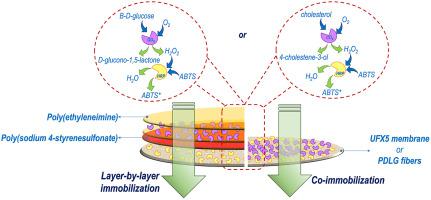Journal of Membrane Science ( IF 8.4 ) Pub Date : 2022-09-19 , DOI: 10.1016/j.memsci.2022.121007 Katarzyna Jankowska , Sigyn Björk Sigurdardóttir , Jakub Zdarta , Manuel Pinelo

|
Glucose oxidase (GOX) and cholesterol oxidase (COX) are enzymes with numerous practical applications in medicine and industry. Although various methods for improving of enzyme stability have been proposed, we present novel approach for enzyme compartmentalization using polyelectrolytes layers deposited on electrospun fibers made of poly(D,L-lactide-co-glycolide) and commercial membrane UFX5. Compartmentalization has a series of advantages over simple co-immobilization offering providing of suitable microenvironment for the immobilized enzymes, ensuring proper substrate/product channeling and improving stability and reusability of biomolecules. The biosystems produced via compartmentalization, resulted in higher conversion efficiency of model reaction at 45 °C and 65 °C compared to free enzymes as well as negative effect of hydrogen peroxide was minimalized after immobilization. Moreover, after 5 catalytic cycles, biosystems based on UFX5 membrane and HRP or GOX or COX immobilized by compartmentalization reached efficiencies of 89% and 34%, respectively, with less than 10% enzyme elution from the support. Enzymes compartmentalized using ultrafiltration membrane showed also significant improvement of their biocatalytic productivity over repeated use, resulting in possible costs reduction of the desired process. Use of biosystems with electrospun fibers and co-immobilized enzymes resulted in enzyme elution of over 90% and very limited conversion efficiency.
中文翻译:

胆固醇氧化酶、葡萄糖氧化酶和辣根过氧化物酶的共同固定和分隔,以提高热稳定性和 H2O2 稳定性
葡萄糖氧化酶(GO X)和胆固醇氧化酶(CO X)是在医学和工业中具有许多实际应用的酶。尽管已经提出了各种提高酶稳定性的方法,但我们提出了使用沉积在由聚 (D,L-丙交酯-co) 制成的电纺纤维上的聚电解质层进行酶区室化的新方法。-乙交酯)和商业膜 UFX5。与简单的共固定化相比,分区化具有一系列优势,可为固定化酶提供合适的微环境,确保适当的底物/产物通道并提高生物分子的稳定性和可重复使用性。与游离酶相比,通过分隔产生的生物系统导致模型反应在 45°C 和 65°C 下的转化效率更高,并且固定化后过氧化氢的负面影响最小化。此外,经过 5 个催化循环后,基于 UFX5 膜和 HRP 或 GO X或 CO X的生物系统通过区室化固定化的效率分别达到 89% 和 34%,从支持物上洗脱的酶少于 10%。使用超滤膜分隔的酶在重复使用时也显示出其生物催化生产率的显着提高,从而可能降低所需过程的成本。使用具有电纺纤维和共固定酶的生物系统导致酶洗脱率超过 90%,转化效率非常有限。

































 京公网安备 11010802027423号
京公网安备 11010802027423号